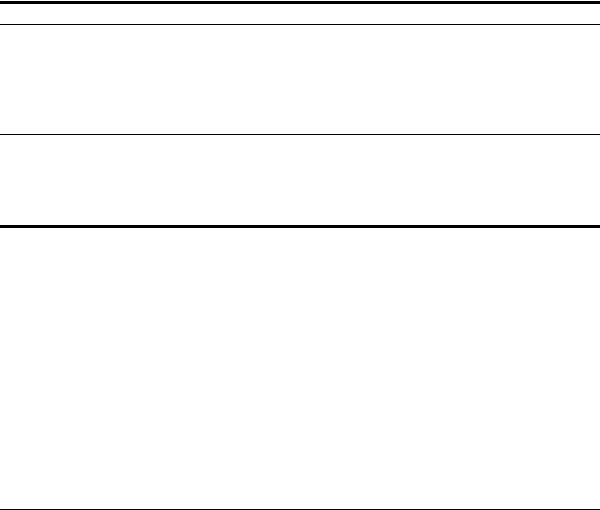
- •Contents
- •Send Us Your Comments
- •Preface
- •1 Introduction to iSQL*Plus
- •What is iSQL*Plus?
- •iSQL*Plus Architecture
- •iSQL*Plus User Interface
- •Oracle HTTP Server
- •Oracle9i
- •2 Configuring iSQL*Plus
- •System Requirements
- •Web Browser (client tier)
- •Oracle HTTP Server (middle tier)
- •Oracle9i (database tier)
- •Installation
- •Configuring the Client Tier
- •Adding MIME Types
- •Adding Proxy Server Exceptions
- •Configuring the Middle Tier
- •Configuring the iSQL*Plus Server
- •Defining a Connection Identifier
- •Setting the iSQL*Plus Session TimeOut
- •Changing the Default Cascading Style Sheet
- •Enabling or Disabling iSQL*Plus
- •Configuring the Oracle HTTP Server
- •Testing the Oracle HTTP Server Configuration File
- •Starting and Stopping the Oracle HTTP Server
- •Configuring the Database Tier
- •iSQL*Plus Security
- •Using Administration Privileges
- •Enabling User Security
- •Adding Entries to an Oracle HTTP Server Authentication File
- •Logging In Using Oracle HTTP Server Authentication
- •Security Usage Notes
- •Configuring Globalization Support
- •Web Browser - client tier:
- •Oracle HTTP Server - middle tier:
- •Oracle9i - database tier:
- •3 The iSQL*Plus User Interface
- •The iSQL*Plus Log In Screen
- •Help Icon
- •Username:
- •Password:
- •Connection Identifier:
- •Privilege:
- •Clear
- •The iSQL*Plus Work Screen
- •Password Icon
- •Log Out Icon
- •Help Icon
- •Enter statements:
- •Script location:
- •Browse...
- •Load Script
- •Execute:
- •Output:
- •Clear Screen
- •Save Script
- •The Change Password Screen
- •Help Icon
- •Username:
- •Old password:
- •New password:
- •Retype new password:
- •Change Password
- •Clear
- •Cancel
- •4 Using iSQL*Plus
- •Running iSQL*Plus
- •Entering Statements
- •Loading Scripts
- •Entering Substitution Variables
- •The Define Substitution Variables Screen
- •Password Icon
- •Log Out Icon
- •Help Icon
- •Define Substitution Variables
- •Submit for Execution
- •Cancel
- •Creating Dynamic Reports
- •Using SET and COLUMN Commands
- •Getting Help
- •Exiting iSQL*Plus
- •5 Command Reference
- •SQL*Plus Command Summary
- •@ (“at” sign)
- •@@ (double “at” sign)
- •/ (slash)
- •ARCHIVE LOG
- •ATTRIBUTE
- •BREAK
- •BTITLE
- •CLEAR
- •COLUMN
- •COMPUTE
- •CONNECT
- •COPY
- •DEFINE
- •DESCRIBE
- •DISCONNECT
- •EXECUTE
- •HELP
- •LIST
- •PROMPT
- •RECOVER
- •REMARK
- •REPFOOTER
- •REPHEADER
- •SHOW
- •SHUTDOWN
- •START
- •STARTUP
- •TIMING
- •TTITLE
- •UNDEFINE
- •VARIABLE
- •WHENEVER OSERROR
- •WHENEVER SQLERROR
- •SQL*Plus Error Messages and Codes
- •iSQL*Plus Error Messages
- •COPY Command Messages
- •PRODUCT_USER_PROFILE Table
- •Creating the PUP Table
- •PUP Table Structure
- •Description and Use of PUP Columns
- •PUP Table Administration
- •Disabling SQL*Plus, SQL, and PL/SQL Commands
- •Creating and Controlling Roles
- •Disabling SET ROLE
- •Disabling User Roles
- •Glossary
- •Index

Send Us Your Comments
iSQL*Plus User’s Guide and Reference, Release 9.0.1
Part No. A88826-01
Oracle Corporation welcomes your comments and suggestions on the quality and usefulness of this document. Your input is an important part of the information used for revision.
■
■
■
■
■
Did you find any errors?
Is the information clearly presented?
Do you need more information? If so, where?
Are the examples correct? Do you need more examples? What features did you like most?
If you find any errors or have any other suggestions for improvement, please indicate the document title and part number, and the chapter, section, and page number (if available). You can send comments to us in the following ways:
■
■
■
Electronic mail: sqlplus@oracle.com
FAX: +61 3 9690 0043 Attn: SQL*Plus Documentation Manager Postal service:
SQL*Plus Documentation Manager Australian Product Development Centre Oracle Corporation Australia Pty Ltd 324 St Kilda Road,
Melbourne, VIC 3004, Australia
If you would like a reply, please give your name, address, telephone number, and (optionally) electronic mail address.
If you have problems with the software, please contact your local Oracle Support Services. There is also an iSQL*Plus Discussion Forum on the Oracle Technology Network located at http://technet.oracle.com/ which may be helpful for iSQL*Plus issues.
vii
viii

Preface
The iSQL*Plus User’s Guide and Reference provides information about the iSQL*Plus user interface, and the Oracle HTTP Server and Oracle9i configuration required to use iSQL*Plus.
This preface contains these topics:
■
■
■
■
■
Audience
Organization
Related Documentation
Conventions
Documentation Accessibility
ix
Audience
iSQL*Plus User’s Guide and Reference is intended for end users and system administrators who perform the following tasks:
■Enter, edit, run store, retrieve, and save SQL commands and PL/SQL blocks.
■Calculate, store, and print query results.
■List column definitions for any table.
■Access and copy data between databases.
■Perform database administration.
To use this document, you need a basic understanding of the SQL database language. If you do not have any familiarity with this database tool, you should refer to the Oracle9i SQL Reference. If you plan to use the PL/SQL database language in conjunction with SQL*Plus, refer to the PL/SQL User’s Guide and Reference for information on using PL/SQL.
Organization
This document contains:
Chapter 1, "Introduction to iSQL*Plus"
Provides introductory information to help you get started with iSQL*Plus.
Chapter 2, "Configuring iSQL*Plus"
Explains how to configure your web browser, the Oracle HTTP Server and Oracle9i.
Chapter 3, "The iSQL*Plus User Interface"
Provides a description of the screens in the iSQL*Plus User Interface.
Chapter 4, "Using iSQL*Plus"
Explains how to use iSQL*Plus and its features.
Chapter 5, "Command Reference"
Provides a reference for commands specific to iSQL*Plus.
x
Appendix A, "SQL*Plus Error Messages"
Provides a list of SQL*Plus and iSQL*Plus Error Messages.
Appendix B, "Security"
Explains how to restrict access to certain SQL*Plus and SQL commands.
Appendix C, "Unsupported SQL*Plus Commands"
Provides a list of commands unsupported in this release of iSQL*Plus.
Glossary
Defines technical terms associated with Oracle and SQL*Plus.
Related Documentation
For more information, see these Oracle resources:
■The SQL*Plus 9.0.1 Release Bulletin containing SQL*Plus general release notes is located in %ORACLE_HOME%\sqlplus\doc\readme.doc.
■The iSQL*Plus 9.0.1 Release Notes containing specific iSQL*Plus release notes are located in %ORACLE_HOME%\sqlplus\admin\iplus\README.htm, or after installation, at http://host.domain/iplus/README.htm.
■SQL*Plus User’s Guide and Reference (Generic Documentation CD ROM).
■SQL*Plus Quick Reference (Generic Documentation CD ROM).
■SQL*Plus Getting Started for Windows (Windows Documentation CD ROM).
Many of the examples in this book use the sample schemas of the seed database, which is installed by default when you install Oracle. Refer to Oracle9i Sample Schemas for information on how these schemas were created and how you can use them yourself.
In North America, printed documentation is available for sale in the Oracle Store at
http://oraclestore.oracle.com/
Customers in Europe, the Middle East, and Africa (EMEA) can purchase documentation from
http://www.oraclebookshop.com/
Other customers can contact their Oracle representative to purchase printed documentation.
xi

To download free release notes, installation documentation, white papers, or other collateral, please visit the Oracle Technology Network (OTN). You must register online before using OTN; registration is free and can be done at
http://technet.oracle.com/membership/index.htm
If you already have a username and password for OTN, then you can go directly to the documentation section of the OTN Web site at
http://technet.oracle.com/docs/index.htm
Whitepapers, sample code, frequently asked questions and other useful information is regularly posted to the SQL*Plus section on OTN at
http://technet.oracle.com/tech/sql_plus/
Conventions
This section describes the conventions used in the text and code examples of this documentation set. It describes:
■
■
■
Conventions in Text
Conventions in Code Examples
Conventions for Windows Operating Systems
Conventions in Text
We use various conventions in text to help you more quickly identify special terms. The following table describes those conventions and provides examples of their use.
Convention |
Meaning |
Example |
|
|
|
Bold |
Bold typeface indicates terms that are |
When you specify this clause, you create an |
|
defined in the text or terms that appear in |
index-organized table. |
|
a glossary, or both. |
|
Italics |
Italic typeface indicates book titles or |
|
emphasis. |
Oracle9i Concepts
Ensure that the recovery catalog and target database do not reside on the same disk.
xii

Convention |
Meaning |
Example |
UPPERCASE Uppercase monospace typeface indicates monospace elements supplied by the system. Such (fixed-width elements include parameters, privileges, font) datatypes, RMAN keywords, SQL
keywords, SQL*Plus or utility commands, packages and methods, as well as system-supplied column names, database objects and structures, usernames, and roles.
lowercase Lowercase monospace typeface indicates monospace executables, filenames, directory names, (fixed-width and sample user-supplied elements. Such font) elements include computer and database
names, net service names, and connect identifiers, as well as user-supplied database objects and structures, column names, packages and classes, usernames and roles, program units, and parameter values.
Note: Some programmatic elements use a mixture of UPPERCASE and lowercase. Enter these elements as shown.
You can specify this clause only for a NUMBER column.
You can back up the database by using the BACKUP command.
Query the TABLE_NAME column in the USER_ TABLES data dictionary view.
Use the DBMS_STATS.GENERATE_STATS procedure.
Enter sqlplus to open SQL*Plus.
The password is specified in the orapwd file.
Back up the datafiles and control files in the
\disk1\oracle\dbs directory.
The department_id, department_name, and location_id columns are in the hr.departments table.
Set the QUERY_REWRITE_ENABLED initialization parameter to true.
Connect as oe user.
The JRepUtil class implements these methods.
lowercase Lowercase monospace italic font monospace represents placeholders or variables.
(fixed-width font) italic
You can specify the managed_clause.
Run old_release.SQL where old_release refers to the release you installed prior to upgrading.
Conventions in Code Examples
Code examples illustrate SQL, PL/SQL, SQL*Plus, or other command-line statements. If users are expected to type them into the system, they are identified by the keyboard icon shown in the margin following. They are displayed in a monospace (fixed-width) font and separated from normal text as shown in this example:
SELECT username FROM dba_users WHERE username = ’MIGRATE’;
Similarly, output from an example is identified by a computer screen icon in the margin as shown in the margin following.
PAGESIZE 24
xiii

The following table describes typographic conventions used in code examples and provides examples of their use.
Convention Meaning Example
[ ] |
Brackets enclose one or more optional |
|
items. Do not enter the brackets. |
{ } |
Braces enclose two or more items, one of |
|
which is required. Do not enter the braces. |
| |
A vertical bar represents a choice of two |
|
or more options within brackets or braces. |
|
Enter one of the options. Do not enter the |
|
vertical bar. |
DECIMAL (digits [ , precision ])
{ENABLE | DISABLE}
{ENABLE | DISABLE} [COMPRESS | NOCOMPRESS]
... |
Horizontal ellipsis points indicate either: |
|
|
■ |
That we have omitted parts of the |
|
|
code that are not directly related to |
|
|
the example |
|
■ |
That you can repeat a portion of the |
|
|
code |
.
.
.
Other notation
Italics
Vertical ellipsis points indicate that we have omitted several lines of code not directly related to the example.
You must enter symbols other than brackets, braces, vertical bars, and ellipsis points as shown.
Italicized text indicates placeholders or variables for which you must supply particular values.
UPPERCASE Uppercase typeface indicates elements supplied by the system. We show these terms in uppercase in order to distinguish them from terms you define. Unless terms appear in brackets, enter them in the order and with the spelling shown. However, because these terms are not case sensitive, you can enter them in lowercase.
CREATE TABLE ... AS subquery;
SELECT col1, col2, ... , coln FROM employees;
acctbal |
NUMBER(11,2); |
acct |
CONSTANT NUMBER(4) := 3; |
CONNECT SYSTEM/system_password
DB_NAME = database_name
SELECT last_name, employee_id FROM employees;
SELECT * FROM USER_TABLES;
DROP TABLE hr.employees;
xiv

Convention |
Meaning |
Example |
lowercase Lowercase typeface indicates programmatic elements that you supply. For example, lowercase indicates names of tables, columns, or files.
Note: Some programmatic elements use a mixture of UPPERCASE and lowercase. Enter these elements as shown.
SELECT last_name, employee_id FROM employees;
sqlplus hr/hr
CREATE USER mjones IDENTIFIED BY ty3MU9;
Conventions for Windows Operating Systems
The following table describes conventions for Windows operating systems and provides examples of their use.
Convention |
Meaning |
Example |
|
|
|
Choose Start > |
How to start a program. For example, to |
Choose Start > Programs > Oracle - HOME_ |
|
start Oracle Database Configuration |
NAME > Database Administration > Database |
|
Assistant, you must click the Start button |
Configuration Assistant |
|
on the taskbar and then choose Programs |
|
|
> Oracle - HOME_NAME > Database |
|
|
Administration > Database Configuration |
|
|
Assistant. |
|
C:\> |
Represents the Windows command |
C:\oracle\oradata> |
|
prompt of the current hard disk drive. |
|
|
Your prompt reflects the subdirectory in |
|
|
which you are working. Referred to as the |
|
|
command prompt in this guide. |
|
HOME_NAME Represents the Oracle home name.
The home name can be up to 16 alphanumeric characters. The only special character allowed in the home name is the underscore.
C:\> net start OracleHOME_ NAMETNSListener
xv

Convention |
Meaning |
Example |
ORACLE_HOME and ORACLE_ BASE
In releases prior to 8.1, when you |
Go to the ORACLE_BASE\ORACLE_ |
installed Oracle components, all |
HOME\rdbms\admin directory. |
subdirectories were located under a top |
|
level ORACLE_HOME directory that by |
|
default was: |
|
■ C:\orant for Windows NT |
|
■ C:\orawin95 for Windows 95 |
|
■ C:\orawin98 for Windows 98 |
|
or whatever you called your Oracle home.
In this Optimal Flexible Architecture (OFA)-compliant release, all subdirectories are not under a top level ORACLE_HOME directory. There is a top level directory called ORACLE_BASE that by default is C:\oracle. If you install release 9.0 on a computer with no other Oracle software installed, the default setting for the first Oracle home directory is C:\oracle\ora90. The Oracle home directory is located directly under
ORACLE_BASE.
All directory path examples in this guide follow OFA conventions.
See Oracle9i Getting Started for Windows for additional information on OFA compliances and for information on installing Oracle products in non-OFA compliant directories.
xvi
Documentation Accessibility
Oracle’s goal is to make our products, services, and supporting documentation accessible to the disabled community with good usability. To that end, our documentation includes features that make information available to users of assistive technology. This documentation is available in HTML format, and contains markup to facilitate access by the disabled community. Standards will continue to evolve over time, and Oracle is actively engaged with other market-leading technology vendors to address technical obstacles so that our documentation can be accessible to all of our customers. For additional information, visit the Oracle Accessibility Program Web site at
http://www.oracle.com/accessibility/
JAWS, a Windows screen reader, may not always correctly read the code examples in this document. The conventions for writing code require that closing braces should appear on an otherwise empty line; however, JAWS may not always read a line of text that consists solely of a bracket or brace.
xvii
xviii
